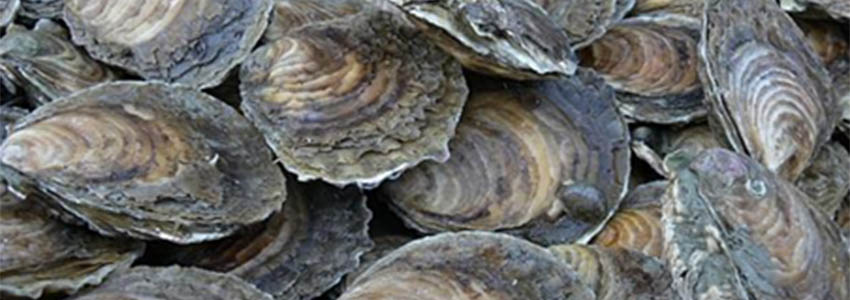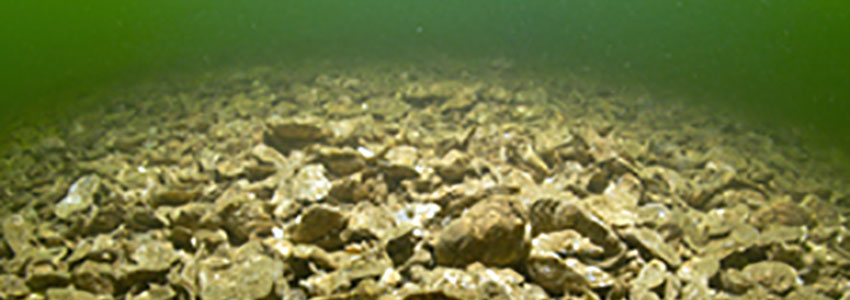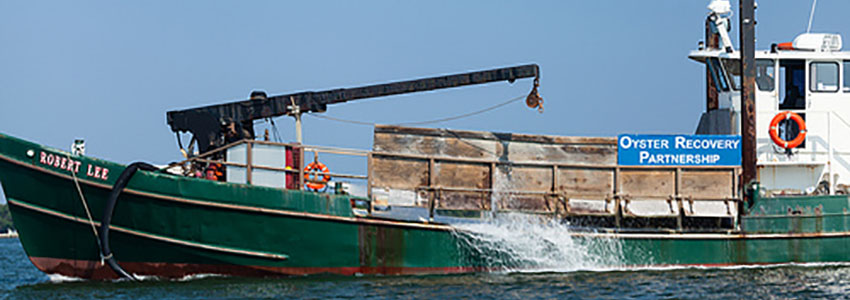Exploring Environmental Issues Related to the Eastern Oyster in Chesapeake Bay is a high school level transdisciplinary unit of study that incorporates both State and National Education Standards for science, with connections to Common Core, and the Maryland Environmental Literacy Standards. There are also strong connections to the College, Career, and Civic Life Standards (C3 Framework for Social Studies), including history, economics, and politics.
The sequence was developed by a team of NOAA educators with guidance from teachers in the Chesapeake Bay region, who reviewed the lessons.
This learning sequence is comprised of four modules, each building on the knowledge and skills of the previous one, and each with different overarching questions. These modules build on in-depth issue analysis skills as students investigate a local environmental issue that they are concerned about and want to investigate. The lessons have been developed with three-dimensional learning in mind, “the idea that science is both a body of knowledge, and an evidence-based model and theory-building enterprise that extends and refines previous knowledge.” (http://www.nextgenscience.org/three-dimensions) The challenge for this investigative unit is to answer the following question: How do we increase Chesapeake Bay oyster populations, while providing economic, cultural, and ecological benefits?
There are four modules in the unit:
- Module 1: A Historical Perspective of Oyster-Related Environmental Issues – The Chesapeake Bay Oyster Wars
- Module 2: Investigating Sustainable Resource Management Using the Fish Banks Simulation
- Module 3: Targeting Oyster Restoration – Evaluating Habitat Requirements for the Eastern Oyster
- Module 4: Environmental Research and Stewardship Action
Module 1: An Historical Perspective of Oyster-Related Environmental Issues
The Oyster Wars of Chesapeake Bay
Teaching Time: 2-3 class periods with some homework
In Module 1: A Historical Perspective of Oyster-Related Environmental Issues – The Chesapeake Bay Oyster Wars, students explore the history of environmental issues associated with Chesapeake Bay oysters, a resource that at one time was the most economically valuable natural resource existing in Bay waters.
To this day, conflicts remain between different groups of people who disagree about how to manage the oyster population in Chesapeake Bay. Students will explore and compare historic and current management issues, and the factors that create environmental conflicts by reading and evaluating journal publications, news articles, or other media sources.
IEEIA model skill development begins in Module 1. With these skills, students will be able to:
- Recognize the differences between environmental events, problems, and issues; and
- Identify stakeholders, their beliefs and values, and the stand they have taken on an environmental issue.
This is the key to thoroughly investigating an environmental issue, and is included in MD Environmental Literacy Standards, Standard 1: Investigating Environmental Issues.
Materials
- Reading resources
- Oyster Wars: The Historic Fight for the Bay’s Riches
- Sixteen decades of political management of the oyster fishery in Maryland’s Chesapeake Bay
- Investigating and Evaluating Environmental Issues and Actions: Skill Development Program (Hungerford, et al, 2003)
- The Oyster Wars of Chesapeake Bay (Wennersten, 1983)
- Computer internet access (optional)
- Projector and screen (optional)
- Teacher pages
- Student pages
- Dry erase board or flip chart, and markers (optional)
Module 2: Investigating Sustainable Resource Management Using the Fish Banks Simulation
Teaching Time: 2-3 class periods with some homework
Module 2: Investigating Sustainable Resource Management Using the Fish Banks Simulation is a role-playing interactive computer simulation that allows teams of students to manage fisheries stocks with “competing” fishing companies. FishBanks, Ltd., https://mitsloan.mit.edu/LearningEdge/
simulations/fishbanks/Pages/fish-banks.aspx illustrates sustainable resource management by demonstrating how the actions of individuals who pursue their own self-interests in the pursuit of economic gain can result in the depletion of a resource that is considered a “common” resource for a larger group of people. A resource “commons” includes water, soil, wild game, timber, and other natural resources, some of which are renewable (sustainable), and others that are not.
There are two versions of the Fish Banks simulation:
Students are very briefly introduced to Fish Banks, before they begin. The process takes a few hours, so more than one class period is required. In the game debriefing “game behavior” is graphed, including how the number of ships affected the total catch and fish population. What is often not considered during game play is the lag time between the decisions made (how hard to fish an area), before a decline in population is observed (the total number of fish caught over years of fishing).
Similarities in the interactions between social and environmental systems are compared in the Fish Banks simulation, with the historic and current fisheries management related issues in Chesapeake Bay.
The Tragedy of the Commons (Hardin, 1968) is included as an extension in this module, which allows students to reflect, and think deeply about how we use common pool resources and how resource management (or no management) affect human and environmental systems for the long term.
Materials
- (1) Computer and (1) printer – Fish Banks Game Kit
OR
(1) Computer per team – MIT Fish Banks simulation
- Projector and screen
- Teacher pages (available through MIT Website or the Game Kit)
- Role Description for each student (available through MIT Website or the Game Kit)
- Student pages
- Dry erase board or flipchart, and markers (optional)
- Reading resources
Module 3: Oyster Restoration — Evaluating Habitat Requirements for the Eastern Oyster
Teaching Time: 3 Class periods with some homework
After reviewing the history, and exploring the concept of sustainability, Module 3: Targeting Oyster Restoration – Evaluating Habitat Requirements for the Eastern Oyster, considers the habitat conditions required for oysters to thrive and reproduce in Chesapeake Bay. Students learn about the oyster life cycle, and different habitat requirements for reproduction, and for the larval through the adult stages.
The University of Maryland Horn Point Oyster Hatchery provides important information, explaining the process of oyster spawning, and the stages of their life cycle.
Using secondary sources of information, including scientific data, students determine the best site(s) for oyster restoration using online tools, including NOAA’s Oyster Decision Support Tool, https://restoreactscienceprogram.noaa.gov/projects/oyster-planning-tool, and other science resources. The interactions of biotic and abiotic factors associated with suitable oyster habitat are evaluated, and students make recommendations of where oyster restoration should occur.
Perhaps the students’ research indicates that there are certain areas that would allow oysters to thrive, but those sites may conflict with other stakeholder uses. Does the site impede traffic for commercial or recreational boaters? Does the proposed sanctuary conflict with oyster harvesting, fishing, or crabbing sites of commercial watermen? Do local waterfront residents believe it will impact the aesthetic appeal or value of their property?
Transcripts from a public hearing regarding the creation of oyster sanctuaries are provided in Module 3. Students once again analyze the resource for stakeholders’ beliefs and values, and are asked to consider solutions to constituents’ primary concerns. The transcripts, however, do not necessarily represent all the possible stakeholders’ opinions about oyster sanctuaries, nor their level of knowledge about how and why particular sites were chosen for protection, among other possible questions.
Using all of the data, skills, and background information thus far, students will practice investigating an environmental issue related to oyster sanctuaries in Chesapeake Bay.
Materials
- Computers with internet access
- Student Pages
- Student Data Sheets
- Student Maps and articles
Module 4: Environmental Research and Stewardship Action
Teaching Time: The length of this module is left to the discretion of the teacher. Since the module is learner-centered, student research can take part in the classroom, and/or as an out-of-class assignment; therefore, the time given for the student to complete their research project could be condensed into a number of weeks, or spread across the semester with defined due-dates for the various research project components.
The final module in the High School Unit, Module 4: Environmental Research and Stewardship Action, provides the opportunity for students to perform an in-depth investigation about an environmental issue of their choosing that applies the IEEIA skills they were introduced to during the first three modules. The issue chosen by the student could be related to oysters, or another local environmental issue that they are concerned about.
Finally, students will learn about different categories of environmental action. They will develop recommendations for solutions to the environmental issue they have chosen, and if motivated, will carry out an action plan.
Together, the learning that takes place in the High School Unit provides students a deeper understanding of how technology, politics, economics, and other components of human social systems influence management of the natural resources and environmental systems that form the foundation of our quality of life. Simple awareness of science-related problems and issues is not enough to inform students of the decision-making process required to wisely manage the resources we depend upon for food or other human necessities. In-depth understanding of how and why we make the choices we do concerning environmental protection is paramount to seeing the “whole picture,” and helps us realize the complexities of environmental issues.
Materials
- Colored markers
- Flip chart paper on which a number of students have room to write
- Resources and reference from Modules 1-3, as needed.
 An official website of the United States government.
Here's how you know we're official.
An official website of the United States government.
Here's how you know we're official.







